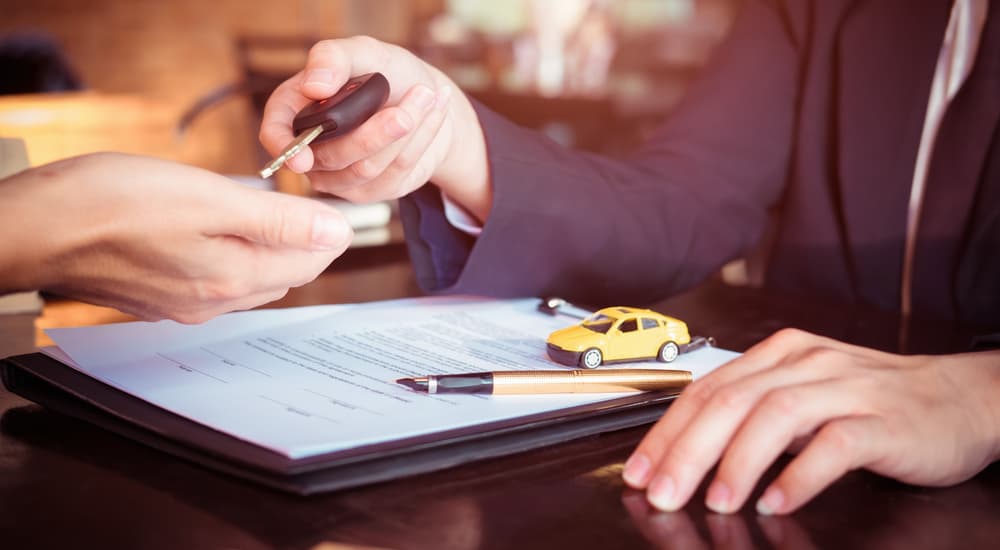If you’re like many Americans in this crazy economic climate, you might be thinking: should you trade in your car at this time? The internet is loaded with articles about why the timing has never been better. Chip shortages are sending used car prices to the moon, causing car owners to consider selling even when swapping vehicles wasn’t part of their plan. It’s easy to understand why these would-be sellers might have dollar signs dancing in their heads.
Not so fast, though. There’s a big risk associated with selling your car privately vs. trading it in to a qualified and certified dealership. Would you potentially get more cash in your pocket? Not always, especially when you consider the time and effort involved in a private vehicle sale. From crafting compelling ads to pulling together the correct paperwork, the process is time-consuming and complex.
Many sellers hold a dated idea of what it means to opt for a trade. They think trading in their vehicle will take a big slice off its potential value. Times have changed, especially now that more buyers are looking twice at pre-owned vehicles. Trading in your car for a new vehicle gets you tons of great benefits, like a full factory warranty and access to the latest safety and infotainment technology.

Trade vs. Sell: Why You Should Reconsider a Private Sale
We’re a connected society, woven together by app-based conveniences like Uber and Google Maps. We can travel, navigate, shop, and interact, all with a device that fits in the palm of our hand. It’s no surprise that automotive retailers are getting in on the app frenzy, designing clever interfaces to capture your business. Whether you’re buying or selling, these services make the transaction almost as fun as a video game. Sure, it’s fun to click through “personalized” recommendations and collect your car at a giant, multi-story glass vending machine, but do these bells-and-whistles actually net you a better-quality vehicle? The answer is it depends. Review sites are filled with nightmare stories about salvage title vehicles, customers who can’t get a human being on the phone, and more.
Ok, so you’re not convinced that a glitzy app is the answer. Maybe you’re more of an online classified site seller/buyer: you have some copywriting skills, and you’re not bad with the iPhone camera, so you craft an ad, load up all the options and features, and hit publish. So far, so good, but when the floodgates open, you’ll be pummeled with spam, inquiries from third-party brokers, and requests for test drives from questionable buyers.
What if you could click one site, determine your car’s value, then close the deal without ever placing an ad or running through a clever app algorithm? You can, but only if you choose to trade your car in to a dealership. To say the process is easy doesn’t do it justice. Sellers have options that don’t involve hours of legwork or upstart Silicon Valley tech companies disguised as experienced automotive retailers.
The Trade-in Process
When you trade your pre-owned vehicle to a dealership, your experience is easy, fast, and predictable. In other words, they skip the long, drawn-out valuation process and make the paperwork straightforward and quick. Not only that, but you won’t have to worry about the terms of your sale changing suddenly, as often happens with an app-based seller. You also won’t have to worry about meeting a sketchy private “buyer” in a dark parking lot.
Getting top dollar for your trade doesn’t require much work on your part when you work with a dealership. When you sell privately, you’ll have to spring for the cost of an ad, but that’s the cheap part. What’s expensive is having your car detailed. A typical bumper-to-bumper detail can cost upwards of $500, and without one, you probably won’t fetch top dollar. Buyers want shiny paint and clean, odor-free cabins.
Did you know that every vehicle comes with its own report card? It’s called a CarFax Vehicle History Report, containing key data about your car, including the number of owners, approximate mileage, and details on previous insurance claims and factory recalls. If your car has hail or flood damage, or if you’ve had an accident that was serious enough to require repairs/bodywork, that information is on the Vehicle History Report, which means potential buyers will see it.
Negative marks on the CarFax Report are a red flag for private buyers but not for a dealership’s acquisition team. If the dealership has an in-house service facility, they have the capability to restore any damage or send the car to a private auction for sale. A dealership’s resources give them a leg up because they’ll be able to confidently purchase your vehicle without worrying about its history. You can’t say that about a private buyer.

Finding a Replacement for Your Trade-in Is Easy
The best part about trading your vehicle to a dealership is the plethora of new models you’ll get to pick from and drive home. Nothing beats that new car smell, and if the dealership has an impressive selection of the most popular SUVs, trucks, and electric vehicles, you’re sure to find the perfect replacement for your trade. It sounds so simple, but how does the trade-in process work?
Most dealerships allow you to get an estimate on your trade-in right on their website. You can plug in the year, make, and model of your current vehicle, along with information about any options or engine upgrades, and instantly receive a trade-in value before you ever step foot in their showroom. From there, you can schedule a time to come by so their acquisition team can physically inspect your car. It’s usually very quick and easy.
Next comes the fun part: you get to shop their huge selection of new vehicles, take a test drive (or two), and decide what you want. In case you were wondering, you can always sell your trade without purchasing another vehicle, but most customers who sell their existing vehicle are looking for a replacement. Once you find the vehicle you want, a sales consultant will work with you to incorporate your trade-in value and secure a low purchase price for your brand new car.
Best of all, you won’t be scratching your head trying to figure out all the paperwork. From titles to bills of sale, it can get confusing. It’s especially stressful when you still owe money on the car you’re selling. All of those details can typically be handled in-house by the dealership’s finance department, so whether you’re buying or leasing, their streamlined approach makes quick work of the necessary paperwork.
Is It Time to Trade In Your Car?
Many drivers wonder when they should move forward with a trade (or a sale). Many factors affect that decision, including the vehicle’s condition, available funds for upgrading, and more. When you work with the experts at a dealership, you can expect to receive personalized suggestions that consider your budget, driving needs, and lifestyle. You don’t have to make such a big decision on your own!
You can also lay to rest the myth that trading your car will net you less overall value. Reputable dealers know how to get you top dollar, no matter which path you choose. Avoid the headaches and potential pitfalls of selling your car on your own and choose the easier way. Working with a dealership will ensure top dollar for your trade and save you the headache of selling your vehicle by yourself.



